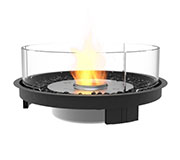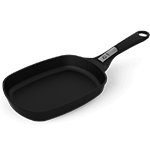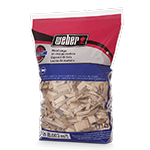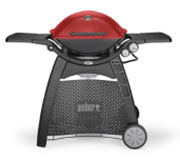Texas-Style Brisket

This recipe, as featured in our cookbook, Weber’s Ultimate Barbecue, will ensure you end up with a brisket that your friends and family will rave out.
RESTING TIME2 TO 4 H
Using a very sharp knife, round off the corners of the brisket. Make sure the brisket has no 90 degree angles. This will help the heat to move aerodynamically across the meat. Trim the fat on the fatty side of the brisket to about 8 mm thick but no less.
On the meatier side, remove the web-like membrane covering the meat so the coarsely grained meat underneath is visible.
Remove any hard clumps of fat on either side of the brisket. Note the section shaped like a wedge between the point and flat. Be sure to cut away most of that fat. If you don’t, that fat will never melt (render).
In a small bowl stir together the pepper and salt. Season the bottom of the brisket first and the fatty side last, making sure you apply the rub evenly on all sides. Refrigerate the brisket until ready to smoke (you can do this up to 12 hours in advance).
Fill a chimney starter with the required quantity of lit barbecue briquettes and light it. Set up the smoker with the required amount of wood chunks and unlit barbecue briquettes.
Pour the lit briquettes in the centre of the unlit briquettes. Fill the water pan three-quarters full with water and assemble the smoker. Wait until the temperature of the smoker reaches about 130°C, 20 to 30 minutes. At this point, you will se some light coloured smoke coming out of the vents. Brush the cooking grills clean.
Place the brisket, fat side up, on the top cooking grill and close the lid. Cook over indirect very low heat, with the lid closed as much as possible.
Cook 4 to 5 hours. Achieving surface colour indicates a good “bark” has been created and the brisket will no longer absorb much smoke. The temperature in the thickest part of the brisket will be around 65° to 71°C, but colour is the primary indication of a good bark.
Arrange two sheets of 90 cm long pink butcher’s paper side by side and overlapping. Fill a spray bottle with the vinegar and water and spray the brisket all over. Transfer the brisket, fatty side up, to the centre of the paper. Fold one long side of the paper over the brisket, bring each side in and over, then roll it up until wrapped and sealed (like a burrito).
Place the wrapped brisket, fat side down, on the top cooking grill over indirect very low heat. Adjust the heat of the smoker as needed to maintain the temperature between 130° and 140°C.
Cook, with the lid closed, until the meat is so tender that when you press it with your fingers through the paper it feels like a giant marshmallow or sponge. This will probably take 5 to 7 hours more.
At that point, the internal temperature should be 94° to 96°C in the flat and 98° to 99°C in the point, though tenderness is a more important indicator of doneness. The amount of time depends on the breed of cattle and other characteristics of the meat. A common mistake is taking the brisket off too early.
Transfer the brisket, still wrapped in the butcher's paper, to a dry, insulated cooler or turned-off oven. Close the cooler or oven and let the meat rest for 2 to 4 hours. Don’t skip this step. It helps loosen the muscles and absorb moisture back into the brisket. The ideal serving temperature of the brisket is 60° to 63°C.
Unwrap the brisket and set it on a cutting board, being careful to keep the precious meat juices in the butcher's paper. Starting with the flat, cut the brisket across the grain into thin slices.
The grain runs differently in the point section, so once you get to that portion of the brisket, you’ll need to turn your knife. First, cut the point in half, then slice each portion across the grain. Serve the brisket warm on buns or bread with barbecue sauce, if using.
A properly cooked brisket is tender but not delicate. If a pencil thick slice falls apart as you are slicing it, that’s overcooked. If, on the other hand, that slice comes apart easily when you tug on it from opposite ends, that’s sheer brisket perfection.
You may hear BBQ aficionados talking about wrapping their meat in butcher’s paper. No, not the white sheets used for school projects. This is a pink—or peach—coloured paper that is used to help protect the meat from drying out once it has developed its beautiful dark bark/crust.
Ingredients
Directions
RESTING TIME2 TO 4 H
Using a very sharp knife, round off the corners of the brisket. Make sure the brisket has no 90 degree angles. This will help the heat to move aerodynamically across the meat. Trim the fat on the fatty side of the brisket to about 8 mm thick but no less.
On the meatier side, remove the web-like membrane covering the meat so the coarsely grained meat underneath is visible.
Remove any hard clumps of fat on either side of the brisket. Note the section shaped like a wedge between the point and flat. Be sure to cut away most of that fat. If you don’t, that fat will never melt (render).
In a small bowl stir together the pepper and salt. Season the bottom of the brisket first and the fatty side last, making sure you apply the rub evenly on all sides. Refrigerate the brisket until ready to smoke (you can do this up to 12 hours in advance).
Fill a chimney starter with the required quantity of lit barbecue briquettes and light it. Set up the smoker with the required amount of wood chunks and unlit barbecue briquettes.
Pour the lit briquettes in the centre of the unlit briquettes. Fill the water pan three-quarters full with water and assemble the smoker. Wait until the temperature of the smoker reaches about 130°C, 20 to 30 minutes. At this point, you will se some light coloured smoke coming out of the vents. Brush the cooking grills clean.
Place the brisket, fat side up, on the top cooking grill and close the lid. Cook over indirect very low heat, with the lid closed as much as possible.
Cook 4 to 5 hours. Achieving surface colour indicates a good “bark” has been created and the brisket will no longer absorb much smoke. The temperature in the thickest part of the brisket will be around 65° to 71°C, but colour is the primary indication of a good bark.
Arrange two sheets of 90 cm long pink butcher’s paper side by side and overlapping. Fill a spray bottle with the vinegar and water and spray the brisket all over. Transfer the brisket, fatty side up, to the centre of the paper. Fold one long side of the paper over the brisket, bring each side in and over, then roll it up until wrapped and sealed (like a burrito).
Place the wrapped brisket, fat side down, on the top cooking grill over indirect very low heat. Adjust the heat of the smoker as needed to maintain the temperature between 130° and 140°C.
Cook, with the lid closed, until the meat is so tender that when you press it with your fingers through the paper it feels like a giant marshmallow or sponge. This will probably take 5 to 7 hours more.
At that point, the internal temperature should be 94° to 96°C in the flat and 98° to 99°C in the point, though tenderness is a more important indicator of doneness. The amount of time depends on the breed of cattle and other characteristics of the meat. A common mistake is taking the brisket off too early.
Transfer the brisket, still wrapped in the butcher's paper, to a dry, insulated cooler or turned-off oven. Close the cooler or oven and let the meat rest for 2 to 4 hours. Don’t skip this step. It helps loosen the muscles and absorb moisture back into the brisket. The ideal serving temperature of the brisket is 60° to 63°C.
Unwrap the brisket and set it on a cutting board, being careful to keep the precious meat juices in the butcher's paper. Starting with the flat, cut the brisket across the grain into thin slices.
The grain runs differently in the point section, so once you get to that portion of the brisket, you’ll need to turn your knife. First, cut the point in half, then slice each portion across the grain. Serve the brisket warm on buns or bread with barbecue sauce, if using.
A properly cooked brisket is tender but not delicate. If a pencil thick slice falls apart as you are slicing it, that’s overcooked. If, on the other hand, that slice comes apart easily when you tug on it from opposite ends, that’s sheer brisket perfection.
You may hear BBQ aficionados talking about wrapping their meat in butcher’s paper. No, not the white sheets used for school projects. This is a pink—or peach—coloured paper that is used to help protect the meat from drying out once it has developed its beautiful dark bark/crust.



























